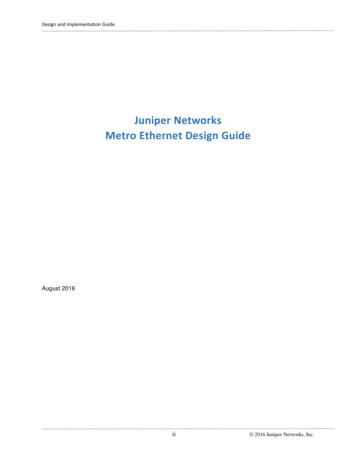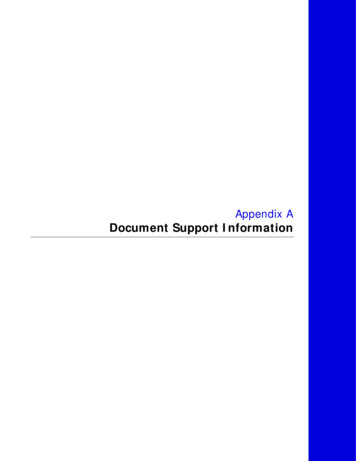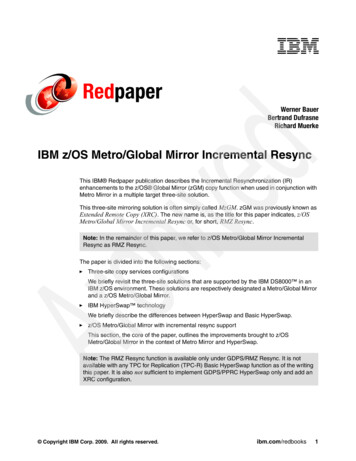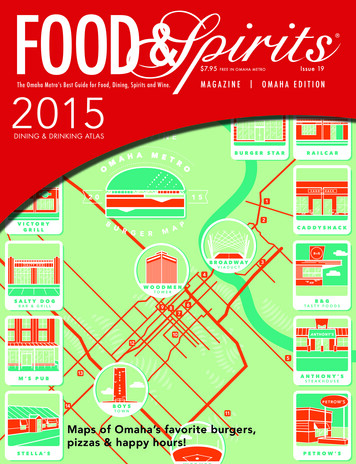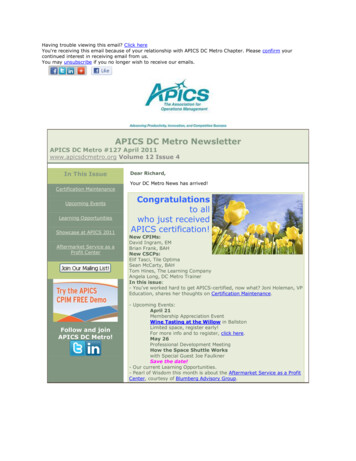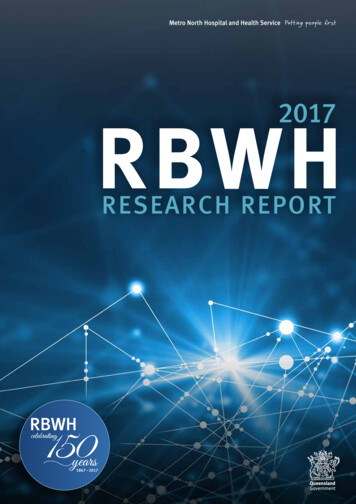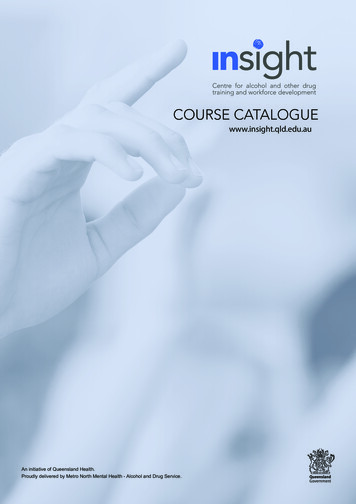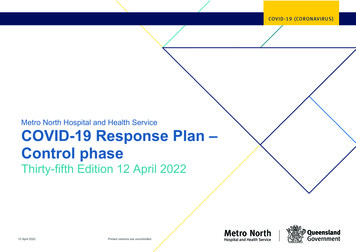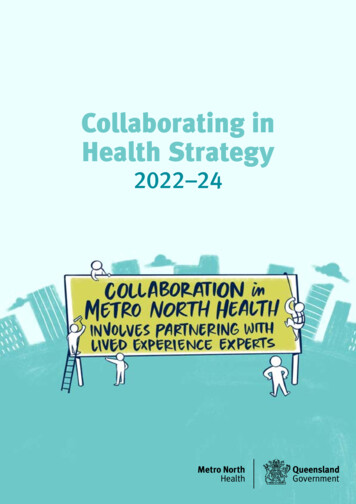
Transcription
Collaborating inHealth Strategy2022–24
Published by the State of Queensland (Metro North Health), December 2021This document is licensed under a Creative Commons Attribution 3.0 Australia licence.To view a copy of this licence, visit creativecommons.org/licenses/by/3.0/au State of Queensland (Metro North Health) 2021You are free to copy, communicate and adapt the work, as long as you attribute the State of Queensland(Metro North Hospital and Health Service).For more information contact:Metro North Engage, Metro North Hospital and Health Service, Block 7, Level 14, RBWH, Herston Queensland 4029,email metronorthengage@health.qld.gov.au , phone 3647 9512.An electronic version of this document is available at isclaimer:The content presented in this publication is distributed by the Queensland Government as an information source only. The State of Queensland makes no statements,representations or warranties about the accuracy, completeness or reliability of any information contained in this publication. The State of Queensland disclaims allresponsibility and all liability (including without limitation for liability in negligence) for all expenses, losses, damages and costs you might incur as a result of theinformation being inaccurate or incomplete in any way, and for any reason reliance was placed on such information. Published by the State of Queensland (Metro NorthHospital and Health Service), December 2021
ContentsGlossary3Foreward – Board Chair and Chief Executive6A message from consumers6Introduction7Our services8Our communities8Our intent for collaboration10Our priorities for consumer and community engagement12Priority 1 – Create authentic partnerships with our diverse communities to improvehealthcare access and experiencesPriority 2 – Cultivate an organisational culture that values, respects and acts uponconsumer input and feedbackPriority 3 – Improve health and digital literacy to support cultural, linguistic, spiritual,social and health needs of consumersPriority 4 – Empower consumers, as partners in, rather than recipients of, theirhealthcare.Priority 5 – Strengthen the collective voice of consumers and communities inhealthcare innovation, research and improvementsCritical success factors16Issues and risks17Implementation and evaluation17Appendix A – Community views on health issues17COLLABORATING IN HEALTH STRATEGY 2022–24 METRO NORTH HEALTH3
GlossaryPerson-centred care – healthcare that is respectful of and responsive to individualchoices, preferences and needs including cultural, linguistic, spiritual, social and healthrelated.Strategy – a document that guides our values, actions and behaviours over a period oftime to achieve a share vision.Consumer – a person who is accessing or may need access to health services includingtheir family and carers. Consumers may represent an individual or the interestsof a group according to age, gender, sexuality, cultural background or health andsocial needs.Patient – a person who is accessing health services. The term “patient” canbe interchanged with “client”, “consumer” or “resident” depending upon thehealthcare context.Carer – an individual who provides, in a non-contractual and unpaid capacity, ongoingcare or assistance to another person who, because of disability, frailty, chronic illness orpain, requires assistance with everyday tasks.Community – refers to groups of people with diverse characteristics who are connectedthrough common location, attitudes, cultures or interests. Individuals can be consideredto be members of multiple communities at once. In the health context, it can be used todescribe the population of the area serviced by an organisation, a cultural group or agroup of people who all experience a particular health condition 1.Community partner – an organisation or representative of an organisation with whomMetro North Health partners to deliver healthcare.Consumer feedback – an umbrella term for all feedback received from consumers andcarers about our services. Feedback can be verbal or written and includes, complaints,suggestions, compliments and patient reported outcome measures (PREMs).Patient reported measures experience (PREMs) – patient perspectives, in their ownwords, on their healthcare experiences collected using standardised surveys and thatguide our actions to improve healthcare. Measures can be quantitative (using scoringmethodology) and qualitative (descriptions of experience).Patient reported outcome measures (PROMs) – a person’s reported experience ofa health condition that comes directly from the person experiencing that condition,without interpretation by a health professional or anyone else. Patient reports mayinclude their health status, quality of life or ability to carry out activities of daily livingassociated with healthcare or treatment.Co-design – a meaningful and authentic process, supported by theory and tools, thatuses common language, shares power and builds partnerships to co-create healthservices. Co-design considers consumers and community representatives to be partnersinvolved from the research and conception phase of an initiative (or reconceptualisation)through detailed planning, design, delivery and review.4COLLABORATING IN HEALTH STRATEGY 2022–24 METRO NORTH HEALTH
Health advocacyIndividual advocacy - the act of representing a consumer, supporting the consumerto represent their own interests and ensuring people are empowered to voice theirperspectives.Systemic advocacy - to introduce, influence or produce positive long-term changes toattitudes, systems, policies and procedures, to remove barriers, address discriminatorypractices and to ensure the collective rights and interests of health consumers areattained and upheld 2.Health literacyIndividual health literacy is the skills, knowledge, motivation and capacity of a person toaccess, understand, appraise and apply information to make effective decisions abouthealth and health care and take appropriate action.Health literacy environment is the infrastructure, policies, processes, materials, peopleand relationships that make up the health system and have an impact on the way thatpeople access, understand, appraise and apply health-related information and services 3.Digital literacy - the skills one needs to live, learn and work in a society wherecommunication and access to information is increasingly through digital technologies likeinternet platforms, social media, and mobile devices 4.National Safety and Quality Health Service Standard 2: Partnering with Consumers - thisis one of eight National Safety and Quality in Health Service Standards (2nd edition)ensuring that health services are responsive to patient, carer and consumer input andneeds5.Directorate - Metro North Health’s organisational structure has 8 directorates. Theyinclude: Royal Brisbane and Women’s Hospital; The Prince Charles Hospital; RedcliffeHospital; Caboolture/Kilcoy Hospitals and Woodford Correctional Centre; STARS (SurgicalTreatment and Rehabilitation Services); Community and Oral Health; Mental HealthServices; and Clinical Support Services.1 Health Consumers Queensland. (2017). Consumer and Community Engagement Framework.2 Health Consumers Queensland (2011). Health Advocacy Framework: Strengthening health advocacyin Queensland.3 Australian Commission on Safety and Quality in Healthcare. (2021). Health Literacy at Health literacy Australian Commission on Safety and Quality in Health Care4 Western Sydney University. (2021). Library Study Smart: What is digital literacy? at What is digital literacy? Western Sydney University5 Australian Commission on Safety and Quality in Healthcare. (2021). The NSQHS Standards at The NSQHSStandards Australian Commission on Safety and Quality in Health Care.COLLABORATING IN HEALTH STRATEGY 2022–24 METRO NORTH HEALTH5
ForewordBoard Chair and Chief ExecutiveJim McGowan AMBoard ChairMetro North HealthJackie HansonActing Chief ExecutiveMetro North HealthA message fromconsumersThe Board and Executive are committed to improvingour services in partnership with the consumers andcommunities we serve. This is Metro North Health’sfourth strategy supporting the evolution of consumerand community partnerships. Over the next 3 yearswe will focus on the known gaps, such as expandingthe diversity of community representation in ourimprovement activities and empowering consumers aspartners in their healthcare journey.We will listen to, learn from and work together totackle the persistent and emerging challenges inhealthcare. This Strategy provides a coherent directionfor collaborating, in an authentic and meaningfulway, with our diverse communities. The Board andExecutive will expand our systems and processes toenable action on the 5 priorities within this Strategy.We will monitor progress on the performancemeasures each year and adapt our actions as theneed arises.In the words of Don Berwick (2013), our Collaboratingfor Health Strategy 2022-24 will ensure that consumersand communities are “present, powerful and involved”in decisions “at all levels of healthcare from thewards to the board”.As an ongoing patient at Metro North Health, I became aconsumer advocate in order to make a positive contributiontowards improving the healthcare system for everyone.It’s also given me insight into how committed staff are toproviding excellent care.– DEBI am a consumer advocate and I have been grateful for theopportunity to provide feedback. My voice as an advocateis respected and listened to and I believe I am making avaluable contribution to the health service. The process isindeed collaborative and I believe making a difference.– PETER6COLLABORATING IN HEALTH STRATEGY 2022–24 METRO NORTH HEALTH
IntroductionThe Collaborating in Health Strategy 2022 – 2024 unites our workforce and communitiesto focus on 5 priorities for collaboration to generate healthcare improvements. Our fiveorganisational values underpin our behaviours and actions for authentic and productivepartnerships. These values are: Compassion, Respect , Integrity, High performance,and Teamwork.Metro North Health Strategic Planning FrameworkCollaborating in Health Strategy 2022 – 2024 is an important component of our localand State strategic priorities. The Metro North Health strategic planning framework isoutlined below.Government prioritiesMy health, Queensland’s future: Advancing Health 2026 sets the vision for Queensland’shealth system – By 2026 Queenslanders will be among the healthiest people in the world.The key directions are: Promoting wellbeing; Delivering healthcare; Connecting healthcareand Pursuing innovation. Queensland Health’s System Outlook to 2026 provides HHSs withdirection to deliver on this vision by informing health service planning, funding and delivery bythe Department of Health and Hospital and Health Services.Queensland HealthMy health, Queensland’s future:Advancing health 2026compassion inclusion excellence empowerment sustainabilityQueensland HealthSystem Outlookto 2026for a sustainable health servicesustainability compassion inclusion excellence empowermentAdvancingHealth 2026System Outlook2026Hospital and health service strategic planThe Metro North Strategic Plan 2020-2024 sets the strategic direction for the health service and aligns tothe priorities of the Queensland Government. The four objectives in the plan are: To always put peoplefirst; to improve health equity, access, quality, safety and health outcomes, to deliver value-based healthservices through a culture of research, education, learning and innovation and to be accountable fordelivery of sustainable services, high performance and excellent patient outcomes. The strategic plandirects the strategy development and planning undertaken across Metro North Health.StrategiesHealth servicesSafety and ntDigital MetroNorth StrategyThere are six headline strategiesfor Metro North Healthfocussing on key functionsof Metro North Health. Thestrategies confirm the strategicdirections and objectives of therelevant area and outlines thepriority strategies required toachieve the desired outcomes.The Health Service Strategyfocuses on health servicedelivery and links with the otherMetro North Health strategies.ActionsCOLLABORATING IN HEALTH STRATEGY 2022–24 METRO NORTH HEALTH7
Our servicesMetro North Health is the largest public provider of health services in Australia.Our vision is to deliver excellent healthcare, working together, strong and healthycommunities. Our services include rural, regional and tertiary hospitals, mental healthservices and community and oral health services.Our communitiesMetro North Health delivers care across a region stretching from metropolitan areason the northern banks of the Brisbane River to rural areas surrounding Kilcoy, as wellas providing specialty services for people residing throughout Queensland, NorthernNew South Wales and the Northern Territory. We have a growing, ageing and diversepopulation. As a culturally and linguistically diverse community, we recognise thatculture, language and health literacy can be barriers to accessing healthcare. Aboriginaland/or Torres Strait Islander peoples and some of our culturally and linguistically diversecommunity continue to experience poorer health outcomes including having a highburden of chronic disease and illness.The infographic opposite provides a summary of the population residing in Metro NorthHealth’s local catchment.8COLLABORATING IN HEALTH STRATEGY 2022–24 METRO NORTH HEALTH
Metro NorthLargest publicprovider4157sq. kmpersons(as at June 2020)NORTH OF Brisbaneriver to KilcoyCulturally andlinguisticallydiverse populationAboriginal and/or Torres StraitIslander people1,062,907DISABILITYLIVING IN NEEDOF ASSISTANCEwith a profound orsevere disability43,4804.6% of MN adult population(2016–2017)1 in 526,982born overseas221,963 people2.6%of MNpopulation(as at June 2019)(as at June 2018)3975 (aged over 50 years)Areas ofdisadvantageHealth risk factorsThird highest HHS populationin Qld (11.4%) behind Cairnsand Hinterland HHS (13.4%)and Metro South HHS (12.9%)High levels ofsocio economicdisadvantage}- Caboolture- Caboolture Hinterland- Bribie – Beachmere- Narangba – Burpengary- RedcliffeObesityPhysical activitySmoking23.5 per cent ofpeople aged 18-75years were classifiedas obese37.5 per cent of people aged 18-75years reported insufficient or nophysical activity8.7 per cent of peopleaged over 18 yearswere daily smokersAlcohol consumption20.1 per cent of people aged over18 years had lifetime risky drinkingconsumptionNutrition46.8 per cent of people aged over 18 years hadless than recommended fruit intake and 94.0per cent of people aged over 18 years had lessthan recommended vegetable intakeThe Health Of Queenslanders 2020, Report of the Chief Health Officer QueenslandBetter or similar to the rest of the State – but could be betterCOLLABORATING IN HEALTH STRATEGY 2022–24 METRO NORTH HEALTH9
Community views on health issuesBrisbane North PHN and Metro North Health undertook extensive consultationwith consumers, staff and community partners from May to August 2021 to explorecommunity views on local health issues. The consultation results highlight issuesimpacting the region as reported by people who participated, which includedrepresentatives from Aboriginal and/or Torres Strait Islander communities and culturallyand linguistically diverse communities. Results are summarised in Appendix A andinclude responses from 502 consumers and/or community members, 46 hospital staff,202 GPs and other health practitioners, 10 partnership groups, and 27 communitypartners.Consumer and community networksAs the largest Hospital and Health Service in Australia, Metro North Health hasestablished many consumer and community networks to guide health servicegovernance across and within each of our 8 directorates. These networks are evaluatedregularly and improved to strengthen consumer voices in shaping health services. In2020-21 more than 120 consumers were engaged in activities across our services.Our intent for collaborationMetro North Health supports the use of the International Association for PublicParticipation (IAP2) framework as a mechanism to better understand community andconsumer engagement. Figure 1 articulates how consumers’ and the communities’perspectives are sought, and how this has an impact on decision making in healthcareimprovements. While all engagement stages are relevant at different times, and they canall be done together, Metro North Health aims to increase the number of initiatives thatare undertaken collaboratively as described in Figure 1.INCREASING IMPACT ON DECISIONS AND EXPERIENCE OF CONSUMER EMPOWERMENTENGAGEMENT GOALINFORMTo provide consumersand community withbalanced and objectiveinformation to assistthem in understandingthe problem, alternatives,opportunities and/orsolutions.CONSULTTo obtain consumersand communityfeedback on analysis,alternatives and/ordecisions.INVOLVECOLLABORATETo work directly with theconsumers and communitythroughout the process toensure that their concerns andaspirations are consistentlyunderstood and considered.To partner with the consumersand community in each aspectof the decision including thedevelopment of alternativesand the identification of thepreferred solution.COMMUNITY-LEDTo place final decisionmaking in the handsof consumers andcommunity.Figure 1: Adapted IAP2 Spectrum of Public Participation. InternationalAssociation for Public Participation www.iap2.org.10 COLLABORATING IN HEALTH STRATEGY 2022–24 METRO NORTH HEALTH
COLLABORATING IN HEALTH STRATEGY 2022–24 METRO NORTH HEALTH 11
Who is responsible for ensuring we deliver on our commitmentsoutlined in this Strategy?Realisation of this Strategy is a shared responsibility involving the Metro North HealthBoard, executives, clinicians and frontline staff, volunteers, students, consumers,communities and partner organisations. The Metro North Partnering with ConsumersProcedure details the roles and responsibilities of many of these stakeholders in our dayto day operations. Implementation of our Collaborating in Health Strategy will focus on 5priorities. These are outlined below.Our priorities for consumer andcommunity engagementPriority 1Create authentic partnerships with our diverse communities toimprove healthcare access and experiences.What we will do1.1 Build respectful relationships and trust with the following communities to facilitateauthentic partnerships: Aboriginal and/or Torres Strait Islander peoplesPeople living with disabilitiesCulturally and linguistically diverse (CALD) communitiesPeople from refugee and asylum-seeking backgroundsYoung peopleCarersPeople who are homeless or vulnerably housedLesbian, Gay, Bisexual, Transgender, Intersex and Queer (LGBTIQ ) peopleOlder peoplePeople living in rural or remote communities.1.2 Empower and resource communities to engage with our services using culturallyappropriate and community-led engagement methods.1.3 Increase representation of consumers, who identify with communities listed in 1.1, inhealthcare design and improvements.1.4 Support the implementation of the Multicultural Action Plan and Health Equity Strategyfor Aboriginal and/or Torres Strait Islander peoples and Reconciliation Action Plans.What we will measureFrequencyThe views of consumers who identify withAnnually commencingcommunities listed in 1.1 are represented and in 2022reflected in quality improvement activities.Performance indicatorAll directorates can demonstrate at least5 quality improvement activities thatspecifically address the issues or concernsof communities listed in 1.1.Consumer feedback for communities listedin 1.1 is being collected by all directoratesand reported to operational leadership teamsfor action.Annually commencingin 2023Consumer feedback is tabled atoperational leadership meetings in alldirectorates and actions taken to respondto feedback are recorded in minutes.There is evidence of community involvementin the Multicultural Action Plan (MAP)and Health Equity Strategy for Aboriginaland Torres Strait Islander peoples andReconciliation Action Plans.AnnuallyProgress reports for the MAP and HealthEquity Strategies document consumer andcommunity involvement.12 COLLABORATING IN HEALTH STRATEGY 2022–24 METRO NORTH HEALTH
Priority 2Cultivate an organisational culturethat values, respects and acts uponconsumer input and feedback.What we will do2.1 Develop workforce competencies, relevant to the role that staff perform, to supportgreater consistency and quality of consumer and community engagement practices.2.2 Continue to expand consumer participation in staff recruitment and selection.2.3 Support the workforce to collect, interpret and act upon qualitative data providedby consumers.2.4 Increase public reporting of consumer feedback and patient reported experiencemeasures (PREMs) and action taken by the health service in response.What we will measureFrequencyPerformance indicatorConsumers involved in improvementactivities feel valued for their time andexpertise.Annually100% of consumers report feeling valued inthe “consumer check-in survey”.An evaluation of consumer participation instaff recruitment is undertaken.2023Staff and consumers have had theopportunity to participate in theevaluation.Public reporting of consumer feedback andaction taken to improve patient experiences.By 2024PREMs results and other forms of consumerfeedback are published on Metro Northwebsites, along with service improvementsimplemented in response to feedback.COLLABORATING IN HEALTH STRATEGY 2022–24 METRO NORTH HEALTH 13
Priority 3Improve health and digital literacy to support cultural,linguistic, spiritual, social and health needs of consumers.What we will do3.1 Develop tailored health communication that is relevant, timely and acceptable toour diverse communities listed in 1.1.3.2 Improve the quality and consistency of health information, in written anddigital formats, to enable communities to access, understand and act upon healthinformation.3.3 Increase the use of proven health literacy practices, by health professionals,such as “teach back” and “show me” when communicating with patients and carers.3.4 Collaborate with consumers to increase access to relevant and timely healthcareinformation, particularly emerging issues of concern such as COVID-19.3.5 Establish partnerships to collaborate on enhancements to health and digitalliteracy within our communities.What we will measureFrequencyPerformance indicatorDemonstration of a variety of communicationBy 2023channels to disseminate health information,such as websites, community forums, radio,newspapers and social media groups is evident.Surveys of departments or teams show avariety of communication channels have beenused.An increase in the proportion of inpatientsindicating “yes definitely” to receivinginformation that prepared them for managingcare at home, as reported in the Queenslandinpatient experience survey.Annually80% of inpatients indicate “yes definitely” toreceiving information that prepared them formanaging care at home, as reported in theQueensland inpatient experience survey by2024.AnnuallyAn increase is observed each year in theproportion of inpatients indicating they receivedculturally or spiritually appropriate resourcesas reported in the Queensland inpatientexperience survey.80% of inpatients indicate “yes” to receivingculturally or spiritually appropriate resourcesby 2024.14 COLLABORATING IN HEALTH STRATEGY 2022–24 METRO NORTH HEALTH
Priority 4Empower consumers, as partners in, rather than recipients of, theirhealthcare.What we will do4.1 Continue to expand and utilise PREMs (patient reported experience measures) to monitor andimprove patient involvement in treatment and care decisions.4.2 Implement a PROMs (patient reported outcome measures) framework to guide a consumercentric approach to the collection and use of patient reported data.4.3 Co-design and co-implement tools that equip consumers with the information and resourcesthey need to be active participants in decisions about their care and treatment.4.4 Partner with community organisations who advocate for and support consumer empowerment.What we will measureFrequencyPerformance indicatorAn increase in inpatients indicating, “yesdefinitely” to being involved as much asdesired in treatment and care decisions inPREMs surveys increases each year.Annually90% of inpatients indicating, “yes definitely” tobeing involved as much as desired in treatmentand care decisions, as reported in the Queenslandinpatient experience survey by 2024.A PROMs framework, developed withconsumer input, has been implemented.By 2022There is evidence clinicians are using theframework to improve patient involvement intreatment and care decisions.Priority 5Strengthen the collective voice of consumers and communities inhealthcare innovation, research and improvements.What we will do5.1 Build consumer and community understanding of the healthcare system to strengthen theirability to influence decisions.5.2 Facilitate consumer collaboratives on issues of importance to consumers to influence systemlevel change.5.3 Contribute to the published evidence for collaboration with consumers and communities inhealthcare.5.4 Support the workforce to engage consumers and community organisations in co-designinginnovation and research.5.5 Acknowledge and celebrate consumers’ contributions to health service improvements.What we will measureFrequencyPerformance indicatorAn increase in consumers who engage in MetroNorth Health activities report being involvedin decisions, or collaborating or leading aninnovation, service improvement or re-design.By 2023At least 60% of consumers completing theconsumer check- in survey indicate they wereinvolved in collaborating, influencing decisions orleading an innovation, service improvement or redesign.Directorates have initiated or progressed at least Annually3 organisational co-design activities annually withconsumers and community.At least 3 co-designed initiatives havecommenced, progressed or been completed eachyear.A framework for co-designing healthcare withconsumers has been developed in collaborationwith consumers.A framework is accessible to staff and consumerswho collaborate on health service initiatives.By 2022COLLABORATING IN HEALTH STRATEGY 2022–24 METRO NORTH HEALTH 15
Critical success factorsFor Collaborating in Health Strategy to be successful we commit to:Organisational culture and capability: Delivering, monitoring and evaluating person-centred outcomes for health care Improving reach and inclusiveness of engagement, focusing on who is notengaged and how to connect with these people and networks Understanding that collaboration requires lead-in time and good planningwith resources and time dedicated to building trusting relationships andimplementing meaningful activities and initiatives Collaboration that is seen as a necessary, long-term process and not a ‘tick thebox’ compliance exercise An organisational culture that is open about its processes and performanceand partners with consumers and community organisations to continuouslyimprove Drivers and leaders of collaboration at the executive-level and “from theground-up” Valuing, respecting and recognising the contribution of consumers andcommunity representatives Processes and systems to support the organisation to partner with consumers Collection of data and evidence of what is working and where improvementscould be made.Skilled, caring and engaging workforce: Developing a workforce that has a strong appreciation for diversity includingculture and languages and the need to ensure both are accommodated indelivery of inclusive services Investing in a skilled and empathetic workforce with the ability to build trustand relationships and deliver person-centred care A mindset of care and respect that values and empowers consumers as activepartners, rather than recipients, in their own health Networking and knowledge sharing for service improvement and leveraging offsolutions already working in Metro North Health as well as other organisations.Consumer and community sector capacity and relationships: Accessing specialised support and advice from Health Consumers Queensland Building capacity within consumer and community sector to enablecollaborative partnerships Enabling consumers to develop knowledge, skills and experience that allowsthem to participate as partners to advocate for themselves and for others.16 COLLABORATING IN HEALTH STRATEGY 2022–24 METRO NORTH HEALTH
Issues and risksIssues and risks if our Collaborating in Health Strategy is not adhered to include: Clinical level – when consumers are not engaged as active partners in theirhealth care and not integral to the services that are delivered, we cannotguarantee high quality, safe services and treatment that result in improvedindividual outcomes. Service level – service design that does not take into account local consumerand community experiences and needs will result in misallocation of resourcesincommensurate to local needs, or not targeted to those who would most benefitfrom them. System level – services will be fragmented, poorly coordinated with aninconsistency of standards between facilities and services, across clinical areas,and primary and secondary health care settings. Demand for the most costly andleast consumer-centric healthcare will grow and be poorly managed, resulting ina disjointed system that is difficult to navigate. Community partner / sector level – relationships will be damaged and sectorcapacity to participate as partners and community will be diminished bytokenistic, poorly-planned and one-way engagement activities that lack integrity. Community / population level – a lack of
Metro North Health Strategic Planning Framework Collaborating in Health Strategy 2022 - 2024 is an important component of our local and State strategic priorities. The Metro North Health strategic planning framework is outlined below. Government priorities Strategies Health services Safety and quality Research Clinical engagement Community .
